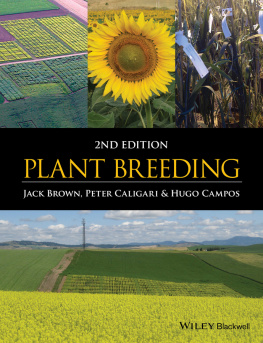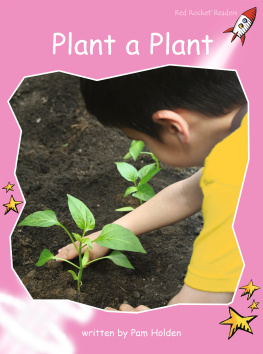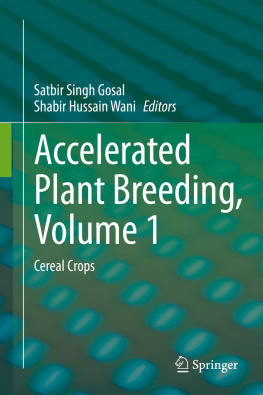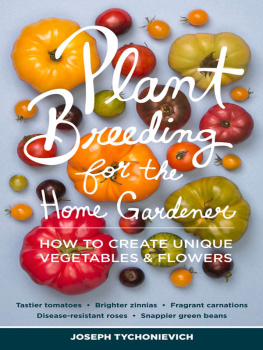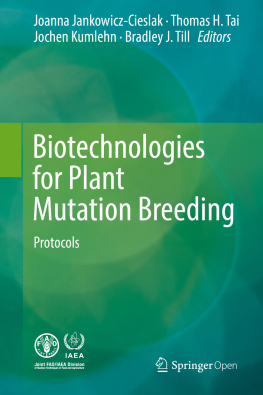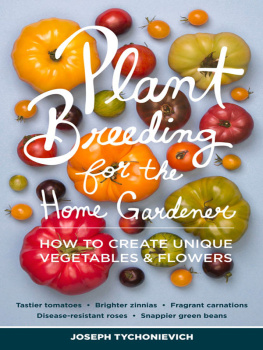Brown Jack - Plant Breeding
Here you can read online Brown Jack - Plant Breeding full text of the book (entire story) in english for free. Download pdf and epub, get meaning, cover and reviews about this ebook. City: Hoboken;NJ, year: 2014, publisher: Wiley Blackwell, genre: Romance novel. Description of the work, (preface) as well as reviews are available. Best literature library LitArk.com created for fans of good reading and offers a wide selection of genres:
Romance novel
Science fiction
Adventure
Detective
Science
History
Home and family
Prose
Art
Politics
Computer
Non-fiction
Religion
Business
Children
Humor
Choose a favorite category and find really read worthwhile books. Enjoy immersion in the world of imagination, feel the emotions of the characters or learn something new for yourself, make an fascinating discovery.
- Book:Plant Breeding
- Author:
- Publisher:Wiley Blackwell
- Genre:
- Year:2014
- City:Hoboken;NJ
- Rating:5 / 5
- Favourites:Add to favourites
- Your mark:
- 100
- 1
- 2
- 3
- 4
- 5
Plant Breeding: summary, description and annotation
We offer to read an annotation, description, summary or preface (depends on what the author of the book "Plant Breeding" wrote himself). If you haven't found the necessary information about the book — write in the comments, we will try to find it.
Plant Breeding — read online for free the complete book (whole text) full work
Below is the text of the book, divided by pages. System saving the place of the last page read, allows you to conveniently read the book "Plant Breeding" online for free, without having to search again every time where you left off. Put a bookmark, and you can go to the page where you finished reading at any time.
Font size:
Interval:
Bookmark:

This edition first published 2014 2014 by John Wiley & Sons Ltd
First edition published 2008 by Blackwell Publishing Ltd..
Registered office: John Wiley & Sons, Ltd, The Atrium, Southern Gate, Chichester, West Sussex, PO19 8SQ, UK
Editorial offices: 9600 Garsington Road, Oxford, OX4 2DQ, UK
The Atrium, Southern Gate, Chichester, West Sussex, PO19 8SQ, UK
111 River Street, Hoboken, NJ 07030-5774, USA
For details of our global editorial offices, for customer services and for information about how to apply for permission to reuse the copyright material in this book please see our website at www.wiley.com/wiley-blackwell.
The right of the author to be identified as the author of this work has been asserted in accordance with the UK Copyright, Designs and Patents Act 1988.
All rights reserved. No part of this publication may be reproduced, stored in a retrieval system, or transmitted, in any form or by any means, electronic, mechanical, photocopying, recording or otherwise, except as permitted by the UK Copyright, Designs and Patents Act 1988, without the prior permission of the publisher.
Designations used by companies to distinguish their products are often claimed as trademarks. All brand names and product names used in this book are trade names, service marks, trademarks or registered trademarks of their respective owners. The publisher is not associated with any product or vendor mentioned in this book.
Limit of Liability/Disclaimer of Warranty: While the publisher and author(s) have used their best efforts in preparing this book, they make no representations or warranties with respect to the accuracy or completeness of the contents of this book and specifically disclaim any implied warranties of merchantability or fitness for a particular purpose. It is sold on the understanding that the publisher is not engaged in rendering professional services and neither the publisher nor the author shall be liable for damages arising herefrom. If professional advice or other expert assistance is required, the services of a competent professional should be sought.
Library of Congress Cataloging-in-Publication Data
Brown, Jack, 1955
Plant breeding / Jack Brown, Peter D.S. Caligari, and Hugo A. Campos.{\emdash}2nd edition.
pages cm
First edition published 2008 by Blackwell Publishing Ltd.
Includes bibliographical references and index.
ISBN 978-0-470-65829-1 (cloth)ISBN 978-0-470-65830-7 (pbk.) 1. Plant breeding. I. Caligari, P. D. S. (Peter D. S.) II. Campos, Hugo A., 1968 III. Title.
SB123.B699 2014
631.5'2dc23
2014011407
A catalogue record for this book is available from the British Library.
Wiley also publishes its books in a variety of electronic formats. Some content that appears in print may not be available in electronic books.
Cover images: Courtesy of Jack Brown
This book has its basis in an earlier text entitled An Introduction to Plant Breeding by Jack Brown and Peter Caligari, which was published in 2008. So why have we produced this current book barely six years after the publication of the previous one? The answer is multiple, but the main driving force is the increasing need of humankind for affordable food, fibres and renewable fuels, which in great part needs to be satisfied through the creation of improved cultivars. Current and future demands from agriculture and an increasing contribution of private breeding organizations, in addition to the more traditional efforts of long-standing public breeding, has significantly improved our knowledge base and the techniques we now have available to improve the efficiency of developing genetically superior cultivars. The challenges facing today's plant breeders have never been more overwhelming, yet the prospects to contribute significantly to global food security and farmers' quality of life have never been more exciting and fulfilling. Let us elaborate further.
- As per United Nations' figures for the year 2013, world population is projected to exceed 8 billion people by 2025, and 9.6 billion by the year 2050. Although most of the projected population growth will take place in developing countries, where over 8 billion will live by 2050, the most significant increase in population will occur in the least developed countries of the world. To place this in simple numbers, every single day over 200,000 additional children needing to be fed are added to the world population.
The rate of accumulation of both fundamental and applied genetic and plant breeding knowledge is ramping up faster than ever before. Drawing from initial research in animal breeding, genomic selection approaches in crop species are being vigorously studied, and their adoption and use into crop breeding programmes has already began. In addition, insights into the molecular basis of genetic variation in plants is being quickly advanced because of the drastic reduction in the cost of DNA sequencing, heavy borrowing from medical translational research; and an increasing awareness of the critical importance of phenotypes to establish better genetic markertrait associations. This holds the promise to significantly improve the efficiency of selecting for a wide range of qualitative and quantitative gene traits in cultivar development.
Furthermore, the traits developed through transgenic approaches are no longer constrained simply to insect or virus resistance or herbicide tolerance. New biotech traits addressing key global needs such as salt and drought tolerance, nitrogen and water use efficiency, or enhancing food quality are now being developed. Initial transgenic breeding efforts were directed towards improving some of the world's major crop species (i.e. maize, soybean, rice, cotton and canola) which are grown on the widest acreage. These techniques are now being applied to other staple crops, as demonstrated by the recent development of a virus-resistant common bean by public scientists based at EMBRAPA in Brazil.
- Despite recent recognition of the need to increase public and private funding into cultivar development, over the last decades there has been a worrying decline in public funding for plant breeding-related research and to supporting international centres for germplasm development and crop improvement. In part, this has resulted in a serious reduction in the number of young people interested in devoting their professional careers to plant breeding, as well as the number of universities offering plant breeding courses or conducting relevant research in plant breeding for the next generation of plant breeders.
Although based on the earlier edition, this book has been completely reviewed, expanded and updated. We have also developed a companion website providing sections such as Suggested answers to the Think Questions, Further reading and Plant breeding teaching material which can be used by lecturers and students alike.
We hope our book will appeal to undergraduate students of plant breeding, as well as providing valuable insight for graduate students, practicing plant breeders and those wishing to advance their understanding of plant breeding.
Our aim is to provide an integrated and updated view of the current scientific progress related to diverse plant breeding disciplines within the context of applied breeding programmes. By and large, plant breeders are integrators of multiple scientific disciplines, including genetics, biology, plant science, agronomy, food science and statistics, as well as having a keen appreciation and understanding of farmers' needs, both current and future. However, plant breeders also need to be aware of global trends affecting agriculture, such as the likely consequences of climate change for crop adaptation and performance.
Next pageFont size:
Interval:
Bookmark:
Similar books «Plant Breeding»
Look at similar books to Plant Breeding. We have selected literature similar in name and meaning in the hope of providing readers with more options to find new, interesting, not yet read works.
Discussion, reviews of the book Plant Breeding and just readers' own opinions. Leave your comments, write what you think about the work, its meaning or the main characters. Specify what exactly you liked and what you didn't like, and why you think so.

